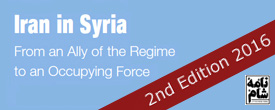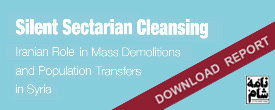If you watch Iranian mainstream TV or read official Iranian newspapers, the impression you often get from their coverage of what’s happening in Syria is that the country is going through a ‘civil war’ between al-Assad’s government, allegedly so beloved and supported by ‘Syrian people’, and various savage armed groups, mostly foreign, described as ‘terrorists’. In the last two months, with the fighting between one of Al-Qaeda-affiliated groups and the rest of the armed opposition reaching unprecedented levels, Iranian mainstream media have found a perfect opportunity to push this narrative even further, and from a higher moral ground, playing on people’s legitimate feelings of repulse and disapproval of religious extremism.
What Iranian mainstream media would never tell their audience, however, is that this particular group, the Islamic State in Iraq and Sham (ISIS), was partly created and supported, in direct and indirect ways, by the Syrian regime and its allies (the governments of Iran and Russia) as a counter-revolutionary tactic.
ISIS has been mostly serving the Syrian regime’s agenda by fighting the other opposition factions and killings their fighters, or taking over areas liberated by the Syrian Free Army and imposing their repressive, unpopular rule in those areas. And that’s partly what led the Syrian opposition to finally declare a war on ISIS in December 2013. For most Syrians, there are now two revolutions in Syria: one against the repressive Assad regime and another against the equally repressive ISIS. The two are often seen as two sides of the same coin. But you would never hear this on Iranian mainstream media, of course.
For example, FARS News, which is known to be close to Sepah Pasdaran, whose members are fighting alongside the regime in Syria, has a special page on the developments in Syria.(1) But the ‘news’ that the page carries mostly revolves around the terrorist activities of ISIS. Yet, not once has the agency bothered to tell Iranians about new revelations proving that ISIS had been deeply infiltrated, if not directed, by the Syrian regime and its allies. Some of the group’s commanders captured by the rebels turned out to have been officers in some of the regime’s elite armed forces. Some were caught with Iranian and Russian passports and had visited these two countries very recently; and so on.
Similarly, most of the ‘news’ reports on Syria and Iraq published on the international page of the Khabar Online website,(2) which is said to be close to Iranian parliamentary spokesman Ali Larijani, are dedicated to ISIS and other terrorist groups linked to Al-Qaeda. Yet, not once has the site bothered to report on what Syrian people themselves are saying about Al-Qaeda. There were many popular protests against ISIS and its repressive rule in the areas under the group’s control well before the armed opposition declared a war against it. This war followed the murder of some opposition commanders and members of other armed Islamist factions at the hands of ISIS.
More importantly, perhaps, none of these state-controlled Iranian media would ever touch the issue that foreign terrorists fighting in Syria are not only Al-Qaeda members fighting against the regime, but also fighters from Sepah Qods, Hezbollah Lebanon and Iraqi militias fighting against the Syrian people. Because that, as everyone in Iran knows, is an official red line that shouldn’t be crossed.
Notes:
(1) http://www.farsnews.com/newsH.php?hoz=279
(2) http://www.khabaronline.ir/service/World
 English
English  فارسی
فارسی  العربية
العربية 




 On Twitter
On Twitter